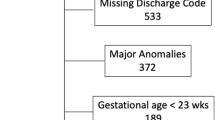Abstract
OBJECTIVE: The American Academy of Pediatrics and American Heart Association sponsored Neonatal Resuscitation Program (NRP) was started in Illinois 1987 to standardize knowledge and skills for successful resuscitation to decrease newborn morbidity and mortality. This study evaluated the hypothesis that the statewide NRP in Illinois hospitals was associated with positive outcomes in the Apgar scores among very low birth weight newborns.
STUDY DESIGN: A retrospective design was used to compare the (a) different rates of lower (0–6) and higher (7–10) 1- and 5-minute Apgar scores and (b) positive change from a lower 1-minute to a higher 5-minute Apgar score before and after NRP was started. Analyses included maternal characteristics, birth weight groups (grams: 500–749, 750–999, 1000–1249, 1250–1499), and hospital levels (I, II, III).
RESULTS: A significantly higher proportion of infants had a higher 1-minute and a higher 5-minute Apgar score after NRP, overall, for Level II and II+ hospitals and for each weight group. Logistic regression indicated that newborns with low 1-minute Apgar scores were 81% more likely to have a higher 5-minute Apgar score after NRP.
CONCLUSION: Significant improvement in Apgar score occurred after NRP. Empirical support is demonstrated for the clinical effectiveness of NRP instruction in Illinois hospitals.
This is a preview of subscription content, access via your institution
Access options
Subscribe to this journal
Receive 12 print issues and online access
$259.00 per year
only $21.58 per issue
Buy this article
- Purchase on Springer Link
- Instant access to full article PDF
Prices may be subject to local taxes which are calculated during checkout

Similar content being viewed by others
References
Bloom RS, Cropley C . Text Book of Neonatal Resuscitation American Academy of Pediatrics, American Heart Association 1987; 90: 94
Apgar V . Proposal for a new method of evaluation of the newborn infant Anesth Analg 1952; 32: 260–2
Hegyi T, Carbone T, Anwar M et al. The Apgar score and its components in the preterm infant Pediatrics 1998; 101: 77–81
Patel D, Piotrowski ZH, Nelson MR, Sabich R . Effect of a statewide neonatal resuscitation training program on the Apgar scores among high-risk neonates in Illinois Pediatrics 2001; 107: 648–55
Casey BM, McIntire DD, Leveno KJ . The continuing value of the APGAR score for the assessment of newborn infants N Engl J Med 2001; 344: 467–71
Weinberger B, Anwar M, Hegyi T, Hiatt M, Koons A, Paneth N . Antecedents and neonatal consequences of low Apgar scores in preterm newborns Arch Pediatr Adolesc Med 2000; 154: 294–300
Pollack MM, Koch MA, Bartel DA et al. District of Columbia Neonatal Network. A comparison of neonatal mortality risk prediction models in very low birth weight infants Pediatrics 2000; 105: 1051–7
Levy BT, Dawson JD, Toth P, Bowdler N . Predictors of neonatal resuscitation, low Apgar scores, and umbilical artery pH among growth-restricted neonates Obstet Gynecol 1998; 91: 909–16
Wilson A, Gardner MN, Armstrong MA, Folck BF, Escobar GJ . Neonatal assisted ventilation: predictors, frequency, and duration in a mature managed care organization Pediatrics 2000; 105: 822–30
Meadow W, Kim M, Mendez D et al. A direct comparison of optional vs. obligatory transfer of infants who require mechanical ventilation born at level II hospitals Neonat Intensive Care 2001; 14: 15–21
SAS User's Guide: Statistics, V6 North Carolina: SAS Institute 1988
Hosmer DW, Lemeshow S . Assessing the fit of the model Applied Logistic Regression New York: Wiley 1989; 9: 135–75
Rosenblatt RA, Mayfield JA, Hart G, Baldwin LM . Outcomes of regionalized perinatal care in Washington State West J Med 1988; 149: 98–102
Jenks SF . Quality assurance J Am Med Assoc 1990; 263: 2679–81
Schmidt B, Kirpalani H, Rosenbaum P, Cadman D . Strengths and limitations of the Apgar score: a critical appraisal J Clin Epidemiol 1988; 41: 843–50
Donabedian A . Explorations in quality assessment and monitoring Volume I. The Definition of Quality and Approaches to Its Assessment Chicago, IL: Health Administration Press 1980
Bower DJ, Wolkomir MS, Schubot DB . The effects of the ALSO course as an educational intervention for residents Fam Med 1997; 28: 187–93
Kaczorowski J, Levitt C, Hammon M et al. Retention of neonatal resuscitation skills and knowledge: a randomized controlled trial Fam Med 1998; 30: 705–11
Schlessel JS, Rappa HA, Aiges H, Verardo LT, Napolitano B . Neonatal resuscitation: family practice first year residents' cognitive and psychomotor skills retention Pediatr Res 1966; 39: 824 (Abstract)
Author information
Authors and Affiliations
Additional information
Partial support provided by a grant from the Neonatal Resuscitation Program Steering Committee, American Academy of Pediatrics. Presented in part as a poster at the American Academy of Pediatrics Section on Perinatal Pediatrics, Annual Meeting in Chicago, Illinois, October 2000.
Rights and permissions
About this article
Cite this article
Patel, D., Piotrowski, Z. Positive Changes Among Very Low Birth Weight Infant Apgar Scores That are Associated With the Neonatal Resuscitation Program in Illinois. J Perinatol 22, 386–390 (2002). https://doi.org/10.1038/sj.jp.7210751
Published:
Issue Date:
DOI: https://doi.org/10.1038/sj.jp.7210751
This article is cited by
-
Efficacy and user preference of two CO2 detectors in an infant mannequin randomized crossover trial
European Journal of Pediatrics (2013)
-
Global report on preterm birth and stillbirth (3 of 7): evidence for effectiveness of interventions
BMC Pregnancy and Childbirth (2010)



